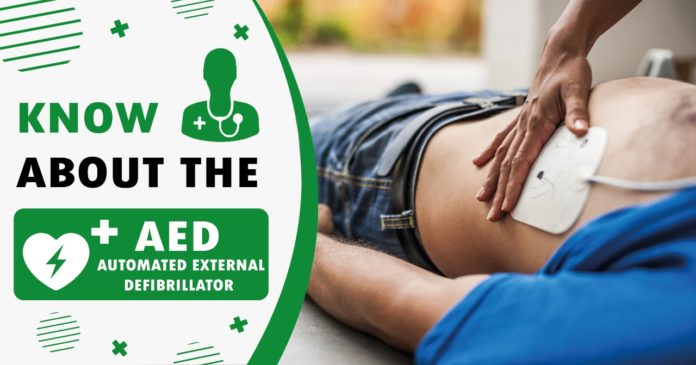An automated external defibrillator (AED) is a portable, life-saving device designed to treat sudden cardiac arrest, a medical situation in which the heart stops beating suddenly and unexpectedly.
Cardiopulmonary resuscitation (CPR) and AED save lives effectively when they are used in the first few minutes after one collapses from sudden cardiac arrest. CPR is a life-saving technique performed when a person falls after a cardiac attack.
Here are the steps to perform CPR:
- Put your dominant hand at the centre of the person’s chest.
- Put your other hand over the dominant hand and lock your fingers in a criss crossway.
- Start giving the chest compressions, press down your interlocked hands on the person’s chest, then come up. Try to push down nearly two or five centimetres and do around 100 compressions per minute. Keep trying until the first heartbeat comes and complete 30 chest compressions.
- After completing the chest compressions, open the person’s mouth and add a rescue breath.
- Continue the chest compressions and keep adding two breath cycles.
The AED includes a battery and pad electrodes. These all are necessary accessories for the AED to deliver the electrical shocks and interpret an electrocardiogram.
There are two main types of AEDs: Public access and Professional use.
- Public access AEDs: They can be primarily found in airports, government buildings, community centres, schools, hospitals, and other public locations. They are used by people who have received minimal training.
- Professional use AEDs: Medical technicians trained for cardiac emergencies and paramedics use these AEDs. They receive additional AED training.
AEDs are semi-automated and fully automated.
- Semi-automated defibrillators
It notices the heart’s rhythm. If an abnormal heart rhythm is detected and requires a shock, the device tells the user to press the button for delivering a defibrillation shock.
- Fully automated defibrillators
It notices the heart’s rhythm and delivers a defibrillation shock. In addition, it gives an automatic shock if required. The fully automated defibrillators can work without user intervention.
AEDs are very easy to carry, and even everyone should purchase this device for emergencies. For example, when a person falls from cardiac arrest and the heart stops beating, they can be performed immediately. It is the best call for cardiac emergencies, which can help to save many lives.
The AEDs save precious treatment time and help to improve the survival odds because they can be used right before the time of emergency medical service (EMS) personnel arrive. By the electric shock of AED, a heart rhythm in ventricular fibrillation can get restored to normal. The AED is very lightweight, compact portable, safe, battery-operated and easy to use.
The Modern AEDs would never allow you to provide an electric shock to a victim with a heartbeat, reducing the risk of doing more harm and causes for people not to come and help. These devices have proved the track record of helping to save thousands of lives in public places and workplaces.





